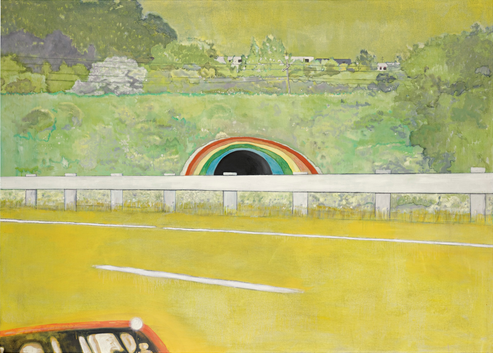
Francis Bacon, Three Studies for Portrait of George Dyer (on Light Ground) (1964), sold in Sotheby’s London June 30th Contemporary Art Evening Auction.
Image: Courtesy Sotheby’s.
A rare triptych picturing Francis Bacon‘s lover George Dyer sold for £26.7 million ($45,463,700) at Sotheby’s tonight, during a contemporary art evening auction which also set new world records for Peter Doig and Adrian Ghenie. The sale grossed £93,147,500 ($158,608,000), flying past its £68 million ($115,788,000) presale estimate, and surpassing last year’s total results of £75,778,500 ($129,033,000) (which included 10 additional lots). It sold a very respectable 86.4 percent by lot and 95.6 percent by value. Yet although the evening saw a few bidding skirmishes between telephone buyers, the room had an unmistakably weary atmosphere. Some blame it on Art Basel, which this year landed on the calendar only a week before the beginning of the London auctions. Eight lots were bought in, including pieces by such blue chip artists as Jeff Wall, Cy Twombly, and Anish Kapoor, and the overwhelming majority of the other lots stayed within estimates, making for little excitement on the floor.
Peter Doig, Country-rock (wing-mirror) (1999), sold in Sotheby’s London June 30th Contemporary Art Evening Auction.
Image: Courtesy Sotheby’s.
Take the star lot: Doig’s Country-rock (wing-mirror). The piece is one of only three paintings in its series. Bought from Gavin Brown’s Enterprise in 1999, the year it was painted, it has remained in the same New York collection since then. The rainbow tunnel motif it prominently features has a particular place in the artist’s vocabulary. “For lovers of Doig, it has a supreme status—akin only perhaps to that of the canoe,” Cheyenne Westphal, co–global head of contemporary art at Sotheby’s told the Telegraph ahead of the sale. So confident was Sotheby’s in the piece’s success that it pitched it above record level, in the region of £9 million. The work hammered very quickly, at £7.5 million ($12,770,700) (equating to a £8,482,500 ($14,443,700) sale with buyer’s premium). So although it did set a new world record for the artist, beating the $11,925,000 paid for Road House (1991) at Christie’s New York last month, it was not nearly as comfortably as one might have thought. And those who hoped that Doig would steal Hirst‘s auction crown and herald a victory of painting over Conceptual art by becoming the UK’s most expensive artist at auction will have had to rethink. It was nonetheless a good night for British painting. Bacon’s Three Studies for Portrait of George Dyer hammered at £23,750,000 ($40,440,600), well above its high estimate of £20 million ($34,055,200), and setting up a new record for a Bacon triptych of this size. The result is very much in keeping with the bullishness of the artist’s market. His Three Studies of Lucian Freud broke all auction records when it sold for $142 million at Christie’s this past November, and his Portrait of George Dyer Talking became the most valuable artwork sold by Christie’s in Europe when in fetched £42 million ($75,515,900) last February.
Francis Bacon, Study for Portrait of P.L., No. 1 (1957), sold in Sotheby’s London June 30th Contemporary Art Evening Auction.
Image: Courtesy Sotheby’s.
This triptych, which has remained in the same collection since its purchase from a Turin gallery in 1970, also has a particular place in the Bacon mythology. The legend claiming that the artist and the East End petty gangster met when Dyer broke into Bacon’s South Kensington studio might not be accurate. But Dyer was one of the great loves of the painter’s life, and a muse for Bacon even long after he killed himself the night before the opening of the artist’s Grand Palais retrospective in 1972. Three Studies, one of only five triptychs of Dyer that exist in this format, is also testament to Bacon’s changing technique, as it is thought to be one of the first works in which the artist used photographs he commissioned from John Deakin as source material. Representing another nude lover, Peter Lacy, Bacon’s Study for Portrait of P.L., No. 1 (1957) also did well, fetching £4,450,000 ($7,577,280)—at the lower end of its higher estimate. It was last seen at auction in 1987, where it was bought for $858,000 (equivalent to today’s $1,732,444.86). Seated Man (1957–8) easily beat its higher presale estimate of £2 million ($3,405,520). Tonight also confirmed a booming market for two painters, one at the climax of his career, the other on a stratospheric rise. A new record was set for the modern British Frank Auerbach with his Primrose Hill (1968) selling for £2,322,500 (3,954,660), almost 10 times’ as much as it did at Christies back in 2003, when it barely reached £274,050 ($454,923), according to the artnet Price Database.
Adrian Ghenie The Fake Rothko (2010), sold in Sotheby’s London June 30th Contemporary Art Evening Auction.
Image: Courtesy Sotheby’s.
Yet the most striking result went to Adrian Ghenie. The Romanian painter based in Cluj was already a global hit. The rumor goes that advisers of all stripes were begging at the doors of his Berlin dealer Galerie Judin during the artist’s last show, hoping for a work that for most remained out of reach. Ghenie is collected by the Centre Georges Pompidou; François Pinault is a fan. But today’s sale of his 2010 painting The Fake Rothko for £1,426,000 ($2,428,140) against a high estimate of £350,000 ($595,966) places him in a different league altogether. The contemporary evening auctions truly concern only about a handful of highly bankable artists—the Warhols, Fontanas, and Richters of this world, those who market commentator Scott Reyburn describes as “investment-grade favorites.” Tonight has proved that Ghenie might well be on the way to becoming one of them.